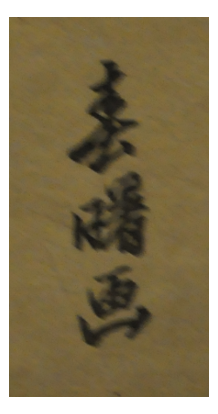Shunshosai Hokucho
Shunshosai Hokuchō (春曙斎 北頂) (

As an Osaka-based artist, Hokuchō's works are categorized as
Works
Hokuchō was not a prolific artist and few prints attributed to him survive. Many of his prints are characterized by yellow backgrounds,
The majority of his prints were published by Honya Seishichi (本屋清七) (Honsei), although he also produced works for the firms Tenmaya Kihei (天満屋喜兵衛) (Tenki) and Yamaichi (山市).[8] He regularly worked with Kasuke, one of the most esteemed woodblock carvers of the period.[9][10]

Modern art historians and critics have not been overly impressed with Hokuchō's skill, describing him as "competent but limited",[11] and less talented than his mentor, Hokushū.[12]
Collections
Works by Shunshosai Hokuchō belong to the permanent collections of various international museums including the following:
- Asian Art Museum
- Museum of Applied Arts, Vienna
- Cleveland Museum of Art
- Museum of Fine Arts, Boston
- Ritsumeikan University [立命館大学]
- Royal Ontario Museum
- Tokyo Municipal Library [東京都立図書館]
- Waseda University Tsubouchi Memorial Theatre Museum [演劇博物館]
- V & A Museum
See also
- Ryūsai Shigeharu - kamigata-e artist
- Utagawa Kunimasu - kamigata-e artist
- Konishi Hirosada - kamigata-e artist
- Yoshida Hanbei - kamigata-e artist
- Actor Ichikawa Ebijūrō as Samurai (Shunshosai Hokuchō)- print by Hokuchō
Notes
- ^ In his exhaustive bibliography of ukiyo-e artists, Kato refers to Hokuchō's contribution— under the name Inoue Shunshosai— in 1839–1840 (Tenpō 10–11) of hanpon sashi-e (版本挿絵) woodblock print book illustrations to 3 different volumes: Kyoto Meishoki (京都名所記), Shūchū Miyako Meishoki (袖中都名所記) and Ehon Otowayama Hana no Shin (絵本音羽山花の賑). Almost all bibliographical references to Hokuchō, however, date the end of his productivity to 1830. Lyon states that Hokuchō's last print was published in the third month of 1833.
- ^ Other members of the school were Gatōken Shunshi, Shunbaisai Hokuei (Shunkō III) and Seiyōsai Shunshi.
- ^ Keyes and Mizushima 1973, 223
- ^ Inoue 1931, 180
- ^ JAANUS, "Kamigata-e"
- ^ Kitagawa 2005, 230
- ^ Lyon 2013
- ^ Lyon 2013
- ^ Lyon 2013
- ^ Doesburg describes Kasuke as "the famous and in those days unrivalled [sic] master-carver."
- ^ Roberts 1980, 51
- ^ Keyes & Mizushima 1973, 224
External links
- Japanese and Chinese Classics, Waseda University Library. "袖中都名所記 (Shūchū Miyako Meishoki)".
- Ukiyo-e.org database. "Shunshosai Hokuchō".
References
- Doesburg, Jan van, Sadamasu: Sadamasu's Career, Huys den Esch, retrieved July 31, 2014
- Inoue, Kazuo (1931), 浮世絵師伝 [Ukiyo-e shiden], Watanabe Hangaten
- JAANUS, Kamigata-e, Japanese Architecture and Art Net Users System, retrieved July 31, 2014
- Kato, Yoshio (2012), Ukiyoeshi sōkan [浮世絵師総覧], Ukiyo-e Bunken Shiryōkan [浮世絵文献資料館], retrieved August 3, 2014
- Keyes, Roger S.; Mizushima, Keiko (1973), The Theatrical World of Osaka Prints, Philadelphia: Philadelphia Museum of Art, ASIN B000XY6OEY
- Kitagawa, Hiroko (2005), "Kamigata-e: The Prints of Osaka and Kyoto", in Newland, Amy Reigle (ed.), The Hotei Encyclopedia of Japanese Woodblock Prints, vol. 1, Amsterdam: Hotei, pp. 229–232, ISBN 9074822657
- Lyon, Mike (2013), Artist: Shunshosai Hokuchō, Lyon Collection of Japanese Woodblock Prints, retrieved August 1, 2014
- Newland, Amy Reigle (2005). The Hotei Encyclopedia of Japanese Woodblock Prints, vol. 2. Amsterdam: Hotei. ISBN 9074822657.
- Roberts, Laurance, P. (1980), A Dictionary of Japanese Artists, New York: John Weatherhill, ISBN 083480235X)
{{citation}}: CS1 maint: multiple names: authors list (link


